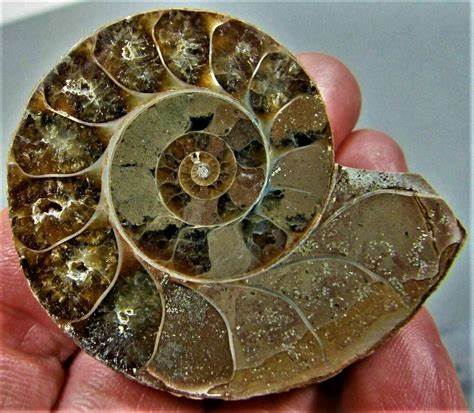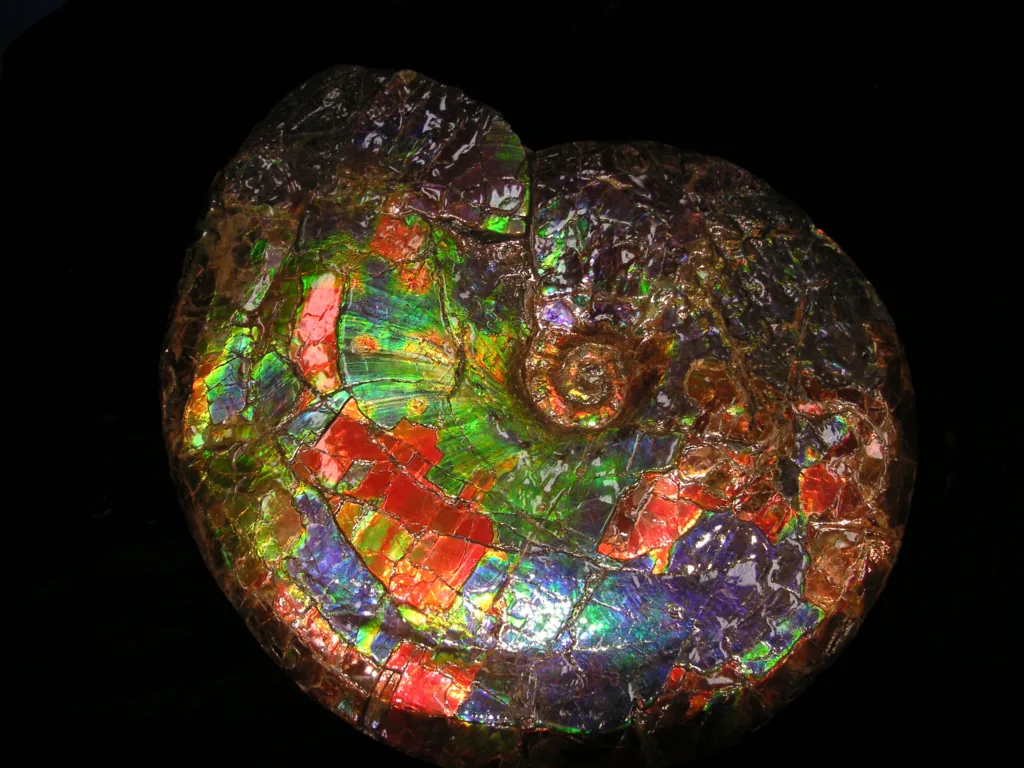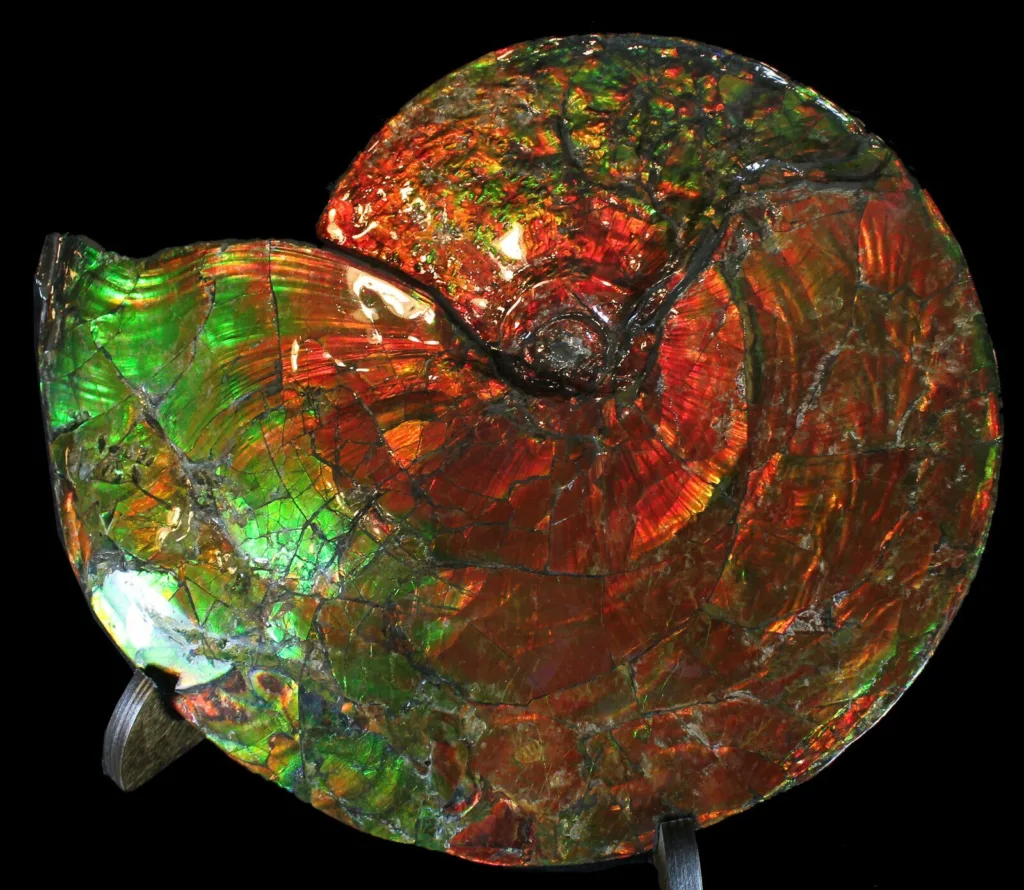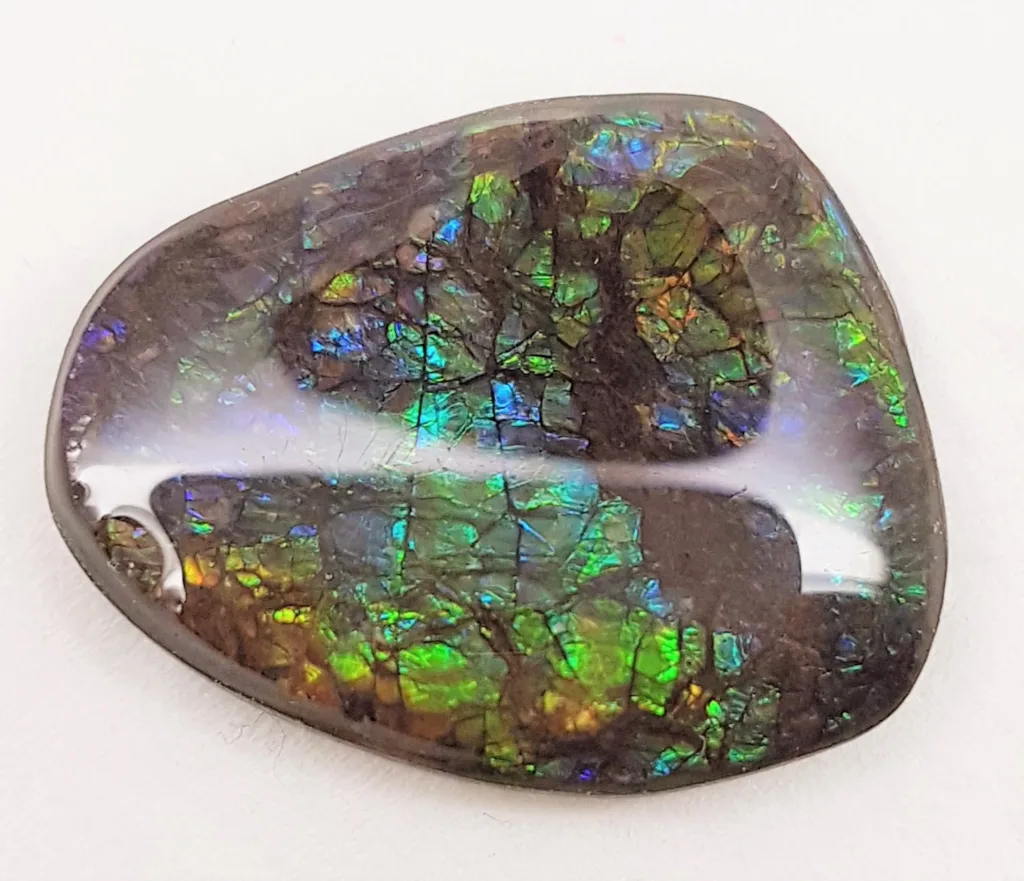Ammolite is a rare and unique gemstone known for its vibrant and iridescent colors. It is formed from the fossilized remains of extinct marine mollusks called ammonites. These mollusks lived approximately 65 to 240 million years ago, during the Cretaceous period, and their fossils can be found in various parts of the world, particularly in the Rocky Mountains of North America.


What sets ammolite apart from other gemstones is its remarkable play of colors. When viewed from different angles, it exhibits a stunning display of vibrant hues, including red, green, orange, yellow, and blue. This phenomenon, known as iridescence, is caused by the interference and diffraction of light as it passes through the thin layers of aragonite, the mineral that composes ammolite.
Ammolite is highly valued for its beauty and rarity, and it is considered a gemstone of high significance to both paleontologists and gem collectors alike. The gemstone is often cut and polished to be used in jewelry, such as pendants, earrings, and rings. It is also popularly used in the creation of decorative objects and inlays for furniture.
The finest quality ammolite gemstones have a vivid and broad color spectrum, with distinct patterns and high transparency. The gemstones are graded based on the intensity and distribution of colors, with the highest quality stones being designated as “AAA” grade.
Due to its limited availability and unique appearance, it is considered a collector’s gemstone. It is also recognized as the official gemstone of the Canadian province of Alberta, where significant deposits of high-quality ammolite are found.
It is worth noting that ammolite is a relatively soft gemstone, with a hardness of 3.5 to 4.5 on the Mohs scale. As a result, it requires proper care and protection to prevent scratches or damage. It is recommended to clean ammolite jewelry with a soft cloth and avoid exposure to harsh chemicals or ultrasonic cleaning.
In recent years, ammolite has gained popularity as a symbol of energy, good luck, and transformation. Some believe that wearing ammolite can enhance vitality, creativity, and overall well-being. It is also associated with the Chinese philosophy of feng shui, where it is believed to bring wealth, abundance, and positive energy to its wearer.
In conclusion, it is a fascinating gemstone formed from the fossilized remains of ammonites. Its incredible play of colors, rarity, and cultural significance make it a highly sought-after gemstone in the world of jewelry and collectibles.
Geological Formation and Discovery

Ammolite is formed from the fossilized shells of ammonites, which were ancient marine mollusks that lived millions of years ago. Ammonites thrived in the oceans during the Mesozoic Era, primarily in the period known as the Cretaceous, between 65 and 240 million years ago. These creatures had coiled shells with intricate chambers that they used for buoyancy and protection.
The process of fossilization and the subsequent formation of ammolite involves several steps. When an ammonite died, its shell sank to the ocean floor, where it was buried under layers of sediment. Over time, the shell was subjected to pressure and mineral-rich waters. The minerals, particularly aragonite, which is a form of calcium carbonate, gradually replaced the original shell material, creating a fossilized replica of the ammonite’s shell.
The unique iridescence and coloration of ammolite are attributed to the organic compounds found within the shell. These compounds underwent a process called diagenesis, which involves chemical and physical changes during the fossilization process. The thin layers of aragonite within the shell interact with light, causing interference and diffraction, resulting in the gemstone’s vivid and shifting colors.
The discovery of ammolite as a gemstone is relatively recent. In the late 1800s, ammolite-bearing rocks were found in the Bearpaw Formation in southern Alberta, Canada. Initially, these rocks were primarily valued for their fossil content rather than the gemstone material they contained. It was only in the 1960s that a Canadian miner named Mike Evernden recognized the gemological potential of ammolite and began promoting it as a gemstone.
Since then, ammolite has gained recognition and popularity among gem enthusiasts and jewelry designers. The majority of commercial ammolite deposits are found in southern Alberta, particularly in the region surrounding the city of Lethbridge. Other minor deposits have been discovered in parts of the United States, such as Montana and Wyoming, as well as in a few other countries, including Madagascar and Morocco.
The geological formation of ammolite is closely tied to the ancient oceanic environments in which ammonites thrived. As these oceanic areas changed over millions of years due to tectonic activity and environmental shifts, the conditions for ammolite formation became limited. As a result, it is considered a rare gemstone, further enhancing its desirability and value in the market.
Distribution
Primarily found in the Bearpaw Formation of southern Alberta, Canada. This region, specifically around the city of Lethbridge, is known for its significant deposits of high-quality ammolite. The Bearpaw Formation is composed of sedimentary rocks that date back to the Late Cretaceous period, providing the ideal conditions for the formation of ammonite fossils and subsequently, ammolite.
In addition to Alberta, smaller deposits of ammolite have been discovered in various parts of the world. Some notable locations include:
- Montana, United States: The state of Montana, particularly the area around the Rocky Mountains, has been known to produce ammolite. The deposits in Montana are geologically related to the Alberta deposits and share similar characteristics.
- Wyoming, United States: Ammolite has also been found in parts of Wyoming, particularly in the Bighorn Basin. These deposits are associated with the same geological formations as those in Alberta and Montana.
- Madagascar: Madagascar is known for its diverse range of gemstones, and ammolite is among the notable finds. Deposits of ammolite have been discovered in the Mahajanga Province of Madagascar.
- Morocco: Morocco has become a significant source of ammolite in recent years. The deposits are primarily found in the Anti-Atlas Mountains in the southern part of the country.
While these regions have yielded ammolite, it is important to note that the deposits outside of Alberta, Canada, are generally smaller in scale and less abundant. Alberta remains the primary and most renowned source of high-quality ammolite gemstones.
It is worth mentioning that the distribution of ammolite is closely tied to the geological history and ancient oceanic environments where ammonites existed. The availability and quality of ammolite deposits are influenced by factors such as tectonic activity, sedimentation patterns, and the preservation of the ammonite fossils over millions of years. Due to its limited distribution and the rarity of high-quality specimens, it is considered a valuable and sought-after gemstone.
Characteristics and Properties of Ammolite

Ammolite possesses several unique characteristics and properties that contribute to its appeal as a gemstone. Here are some key features of ammolite:
- Color and Iridescence: The most distinctive aspect of ammolite is its remarkable play of colors. When viewed from different angles, it exhibits a vibrant and shifting range of hues, including red, green, orange, yellow, and blue. This iridescence is caused by the interference and diffraction of light as it passes through the thin layers of aragonite, the mineral that forms ammolite.
- Patterns and Variation: Often displays striking patterns and designs within its iridescent colors. These patterns can include undulating lines, swirls, and even the shapes of the original ammonite shell. The patterns and color distribution can vary greatly from one ammolite gemstone to another, making each piece unique.
- Hardness: has a hardness of 3.5 to 4.5 on the Mohs scale. While it is not as hard as some other gemstones, such as diamonds or sapphires, it is still suitable for jewelry use. However, due to its relatively soft nature, ammolite should be handled with care to avoid scratches or damage.
- Transparency: gemstones can range from translucent to opaque, with varying degrees of transparency. Higher-quality ammolite typically exhibits greater transparency, allowing more light to pass through and enhancing the play of colors.
- Size and Shape: is often cut and shaped into various gemstone cuts, including cabochons, faceted gemstones, and freeform shapes. The choice of cut depends on the desired design and the unique features of the individual ammolite stone.
- Density and Weight: has a density of approximately 2.6 to 2.85 g/cm³. Its weight can vary depending on the size and thickness of the gemstone.
- Size Limitations: Due to the limited size of ammonite fossils, large ammolite gemstones are relatively rare. The average size of ammolite gemstones used in jewelry ranges from a few millimeters to a few centimeters, although larger specimens can be found.
- Stability and Care: is considered stable for everyday wear and does not require any special care beyond regular cleaning. However, it is important to protect ammolite from exposure to harsh chemicals, extreme heat, and direct sunlight for prolonged periods to maintain its colors and quality.
Overall, the unique play of colors, patterns, and the individual characteristics of each ammolite gemstone make it a captivating and sought-after gem for jewelry and collector’s pieces.
Uses of Ammolite

Ammolite is primarily used in the creation of jewelry, decorative objects, and inlays. Here are some of the main uses of ammolite:
- Jewelry: Ammolite gemstones are cut and polished to create stunning pieces of jewelry. They are often used in pendants, earrings, rings, bracelets, and brooches. Ammolite’s vibrant colors and iridescence make it an attractive choice for unique and eye-catching jewelry designs.
- Decorative Objects: Ammolite is also used to create decorative objects, such as sculptures, figurines, and art pieces. Its distinctive colors and patterns make it a popular choice for adding a touch of elegance and natural beauty to interior decor.
- Inlays and Mosaics: The thin slices of ammolite can be used as inlays or mosaics in various objects. It is commonly incorporated into furniture, wall panels, boxes, and other items to add a touch of color and visual interest. Ammolite inlays are particularly valued for their unique and striking appearance.
- Collectibles: Due to its rarity and the unique properties of each individual ammolite gemstone, it is highly sought after by gem and fossil collectors. Ammolite specimens with exceptional colors, patterns, and quality are considered valuable collector’s items.
It is important to note that ammolite is primarily used for its aesthetic appeal and not for its durability or hardness. Due to its relatively soft nature, ammolite jewelry should be handled and cared for with caution to avoid scratching or damaging the gemstone.
Overall, ammolite’s unique colors and patterns, coupled with its rarity, make it a versatile and highly valued gemstone for jewelry, decorative purposes, and as collector’s items.
References
- Prokopiuk, T. C. (1993). Ammolite: iridescent fossil gemstone from the Cretaceous of Alberta, Canada. The Canadian Mineralogist, 31(4), 1031-1050.
- Ammolite. (n.d.). Gemological Institute of America (GIA). Retrieved from https://www.gia.edu/ammolite
- Ammolite. (n.d.). International Gem Society (IGS). Retrieved from https://www.gemsociety.org/article/ammolite-jewelry-and-gemstone-information/
- Ammolite Information. (n.d.). Geology.com. Retrieved from https://geology.com/gemstones/ammolite/
- Ammolite. (n.d.). Mindat.org. Retrieved from https://www.mindat.org/min-313.html
- Phillips, T. (2019). Ammolite. G&G, Gems & Gemology, 55(4), 542-543.




































